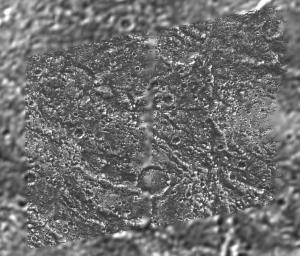A mosaic of four Galileo images of the Galileo Regio region on Ganymede (Latitude 18 N, Longitude: 149 W) is shown overlayed on the data obtained by the Voyager 2 spacecraft in 1979. North is to the top of the picture, and the sun illuminates the surface from the lower left, about 58 degrees above the horizon. The smallest features that can be discerned are about 80 meters (262 feet) in size in the Galileo images. These Galileo images show fine details of the dark terrain that makes up about half of the surface of the planet-sized moon. Ancient impact craters of various sizes and states of degradation testify to the great age of the terrain, dating back several billion years. The images reveal distinctive variations in albedo from the brighter rims, knobs, and furrow walls to a possible accumulation of dark material on the lower slopes, and crater floors. High photometric activity (large light contrast at high spatial frequencies) of this ice-rich surface was such that the Galileo camera's hardware data compressor was pushed into truncating lines. The north-south running gap between the left and right halves of the mosaic is a result of line truncation from the normal 800 samples per line to about 540. The images were taken on 27 June, 1996 Universal Time at a range of 7,580 kilometers (4,738 miles) through the clear filter of the Galileo spacecraft's imaging system. Launched in October 1989, Galileo entered orbit around Jupiter on December 7, 1995. The spacecraft's mission is to conduct detailed studies of the giant planet, its largest moons and the Jovian magnetic environment. The Jet Propulsion Laboratory, Pasadena, CA manages the mission for NASA's Office of Space Science, Washington, DC.
This image and other images and data received from Galileo are posted on the World Wide Web, on the Galileo mission home page at http://galileo.jpl.nasa.gov. Background information and educational context for the images can be found at http://www.jpl.nasa.gov/galileo/sepo.

 Planetary Data System
Planetary Data System












